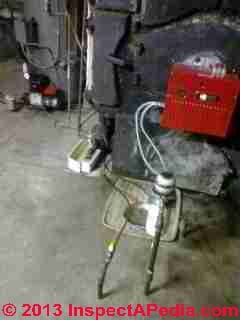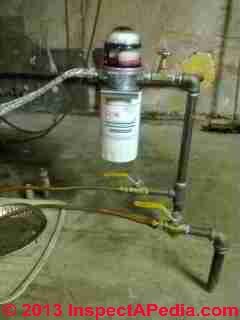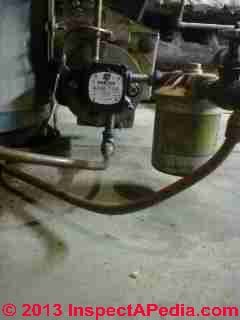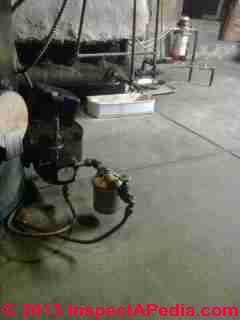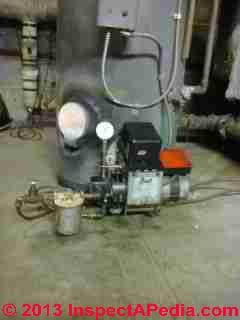 Heating Oil Line De-Aerators
Heating Oil Line De-Aerators
Installation & troubleshooting oil pipe air removal devices such as the TigerLoop™
- POST a QUESTION or COMMENT about oil piping, air problems, prime loss, foaming, on oil-fired heating equipment
This article discusses the installation and use of oil line de-aerators to remove foam or frothing in heating oil supplied to an oil burner.
We include a discussion about troubleshooting problems on oil heat that a reader said began after installing a TigerLoop™ de-aerator on the system.
InspectAPedia tolerates no conflicts of interest. We have no relationship with advertisers, products, or services discussed at this website.
- Daniel Friedman, Publisher/Editor/Author - See WHO ARE WE?
Oil Line De-Aerators & Prime Protection Devices
 Watch out: if your oil heating system is suffering from recurrent loss of prime in the oil delivery system, poor burner operation because of air in the system, or loss of heat because of loss of oil delivery, before installing an oil-line de-aerator, be sure that there is no air leak in (or oil leak out) of the oil piping itself.
Watch out: if your oil heating system is suffering from recurrent loss of prime in the oil delivery system, poor burner operation because of air in the system, or loss of heat because of loss of oil delivery, before installing an oil-line de-aerator, be sure that there is no air leak in (or oil leak out) of the oil piping itself.
Besides oil piping leaks, improper oil piping routing or requiring the fuel unit to lift oil higher than it can, use of a single oil line where supply and return piping is needed are examples of other problems leading to loss of prime and bad burner operation.
Those details are at OIL SUPPLY LINE PIPING LEAKS
Watch out: leaks in heating oil appliance piping or filters can result in improper oil burner operation, soot clogging, and even a loud bang at oil burner start-up or worse, a dangerous puffback.
Details are at PUFFBACKS, OIL BURNER
Tigerloop™ and other Oil Line Devices to Maintain Prime and Simplify Oil Piping
If your oil burner uses a Tigerloop® oil-line de-aerator (photo at left) to remove air or foam from the incoming oil line, the company notes that UL requires a fusible link oil valve installed in the (bottom) center (inlet) port of the Tigerloop™ device.
[Click to enlarge any image]
Tigerloop™ is an oil de-aerator installed at the oil pump (fuel unit) on an oil burner. It can help avoid losing prime on heating oil lines if there is a problem with air leakage into the oil piping.
Watch out: Tigerloop™ adds that you should never install an oil line shutoff device between the de-aerator device and the oil pump. Shown is the Tigerloop S220. A variation is available, the Tigerloop-ultra™ S-220-8 that incorporates an oil filter as well.
The manufacturer, Westwood, indicates in an article quoted from Fuel Oil News magazine that using the Tigerloop™ model TN device permits omission of the return oil pipe traditionally used with buried or distant heating oil tanks.
- Westwood Products, WHY USE TIGERLOOP® in FUEL HEATING SYSTEMS [PDF], Westwood Products Inc. 330 William Street South River, NJ 08882 USA Tel: 1-800-442-1630 Website: www.westwoodproducts.com retrieved 2018/03/14, original source: http://www.westwoodproducts.com/images/tigerloop_is_reliability_us.pdf
- Oventrop, HEATING OIL DEAERATOR TIGER LOOP TECHNICAL INFORMATION [PDF] Oventrop Corporation 29 Kripes Road East Granby, CT 06026 USA, Telephone (860) 413-9173 Website: www.oventrop.com
- Also see OIL BURNER FUEL UNIT AIR BLEED PROCEDURE - how to get air out of oil lines & oil burners after running out of oil
- Also see OIL BURNER MANUALS
Watch out: Tigerloop™ warns that you should never install an oil line shutoff device between the de-aerator device and the oil pump.
Or as reader T.R. clarifies: ... I've been reading about TigerLoop oil fuel line de-aerators. When they are used, the manufacturer recommends that the fusible valve near the burner be attached at the inlet of their de-aeration device.
Details about a suspected leak in oil line piping where a de-aerator or oil line air removal device is installed are in a Q&A discussion found
at OIL SUPPLY LINE PIPING LEAKS or select a topic from the closely-related articles below, or see the complete ARTICLE INDEX.
Details about how to get rid of air in the oil piping system are
at OIL BURNER FUEL UNIT AIR BLEED PROCEDURE for steps in removing air from oil piping and fuel units at oil burners such as after running out of heating oil.
De-Aerator Problems with Air Leaks in Oil Line Piping
Reader Question: issues ever since a de-aerator was installed
My aunt's heating system is been having issues ever since a de-aerator was installed.The system has a 1,000 gal inground tank that is a fair distance from the boiler room.
What happens is that when the tank gets to about half empty, suddenly the hot water heater's oil burner has difficulty staying on....
I have read through your website pages and need to find some clarification as to how the de-aerator should have been connected... I am attaching photos so you can see the system...
The oil supply line runs to the main furnace and before the de-aerator it feeds off to the hot water heater. The return line is currently only being used as a return for the hot water heater burner.
All summer when just the hot water heater was running there were no problems.... and if there is more than half a tank of oil there is no problem, but the hot water burner's pump seems to have vast difficulty getting the lift and suction to pull in the oil once the tank goes below half full.
Could there be a problem with the de-aerator sending air back that instead goes in the supply line to the hot water oil burner?
Could the hot water burner pump be just too weak in comparison to the de-aerator's effect when it is running and thus causes a drop in supply pressure at the hot water burner and it cuts out?
I asked the fellow who services the system if he had cleaned the screen of the pump and he said it wouldn't need to be because there is a filter on the line. Ideally I would like to change the pump out and see if the pump is the issue -- whether it is clogged or just getting weak, changing it with a new unit would resolve any issue there, but perhaps it should have a stronger pump instead?
It just seems to me when I look at the system that was installed that it is imbalanced on the supply line between the two burners.... one is pulling oil much stronger than the other - E.I. 12/26/2013
Reply: troubleshooting oil supply problems after installing a de-aerator devicve
 A competent onsite inspection by an expert usually finds additional clues that would permit a more accurate, complete, and authoritative answer than we can give by email alone. And I suspect that's what's needed in the case you describe
A competent onsite inspection by an expert usually finds additional clues that would permit a more accurate, complete, and authoritative answer than we can give by email alone. And I suspect that's what's needed in the case you describe
I'm not confident that I can accurately diagnose the trouble by email, even with your excellent photos. But your photos and your email did suggest several questions to me:
1. Incomplete oil line return piping: If we are supplying two oil-fired devices from a buried oil tank, why would there be a return piping system only for one of the appliances?
Typical fuel units on oil fired heating equipment have limited lift capacity - it's not uncommon for a system to work acceptably when fed from a remote buried oil tank only when the amount of lift needed is lowest - when the tank is closer to full.
I can imagine several problems: for example when both appliances are trying to draw oil from the tank the vacuum level in the supply line is different than when just one is running. And the appliance without a return line is much more likely to have trouble obtaining adequate fuel flow.
2. Incomplete oil burner service: a heating guy who thinks that it is never necessary to replace the screen in the fuel unit when servicing the heating system must have different training and field experience than mine and different from other more experienced heating technicians who've taught me.
Good practice is to exchange the filter screen in the fuel unit when servicing the system. It's an inexpensive part - but a bit more time to perform the task. I suppose that if the oil supplied in some areas is unusually clean and every oil storage tank in an area is new and none have sludge and debris accumulations a technician's experience may not include attention to this service step.
3. Watch out: improper shutoff valve location: One of your photos (#041) shows what looks like a manual shutoff valve on the oil return line - a serious fire hazard should a fire otherwise occur in the area. I could not see where fusible-link oil safety valves were installed, but general good practice installs those valves only on the supply line, and we install a one way check valve on the return line.
We don't want to close off the return line with a fusible link valve NOR with a manual valve as doing so risks blowing a line and spewing fuel oil adding to the fire in the event of a fire in the utility are. Do not install a second fusible-link fire safety valve (OSV) shutoff-valve on the return oil line. Use a check valve instead.
Details are at DUAL OIL LINE 2 VALVES
4. Oil line leaks: I would not expect recurrent air problems in a residential type heating oil piping system unless there were an air leak somewhere in the oil piping.
I'd want an expert who knows how to perform vacuum testing or pressure testing to inspect this system for leaks as well as for proper valve location and safety.
The fact that the heating system has been having trouble ever since the [heating oil supply piping] de-aerator was installed indeed suggests an installation problem, of which the first thing I'd check would be for a leak in the oil piping system, for example, perhaps a bad flare connection. But some of the other installation details I cite mean that something doesn't smell right from what you've told me.
Also see OIL BURNER FUEL UNIT AIR BLEED PROCEDURE
5. Improper de-aerator installation: review the guidance at
OIL SUPPLY & RETURN LINE DE-AERATORS Tigerloop™
to be sure that your de-aerator is properly installed and working.
Also you can contact the company directly:
- Tigerloop: oil line de-aerator devices, Westwood Products Inc., 330 William St., PO Box 610, South River, NJ 08882-0610 - (732) 651-7700
Reader follow-up:
It is a shutoff on the return line, and I raised it with the tech, asking that it be changed to a check valve, and he didn't share my concern about it. The first tech is the one who installed it
I also don't like the fact that the pressure gauge was left installed in the pump. Is it odd though that the burner quits without the reset light coming on?
Reply:
When I encounter someone who is "not concerned" about a mistake that could, by spewing fuel oil onto a fire at the heating system, increase the chances that we burn down the house or kill occupants in it,
I figure the person is both ignorant and has a sensitive ego, reluctant to or afraid to admit that ignorance - a very human trait that is understandable, but that is unfortunate in one whose work involves life safety as well as operating costs for his or her clients.
I generally will not argue with such a person as it is a waste of time and just makes them mad. But I'd ask the service manager to send me someone with proper training. If necessary you can obtain a copy of your state's fuel and gas piping & connections code or cite one of the model codes on oil line piping.
We list helpful sources on oil piping codes at Citations &References or Citations at the end of this article. While some of the key standards are easily obtained by purchase from the standards-writing organization, they may also be available free of charge where the standard has been incorporated into a state or city building code.
NFPA 30 prohibits a shut-off valve in the return oil piping that forms the feed back to the oil tank in a two pipe heating oil system. A manual shutoff or gate valve or an oil safety valve that shuts in the event of a fire are both prohibited by this guideline. Also
see OIL SUPPLY LINE SAFETY VALVES, OSVs.
About the gauge left in place on the fuel unit, there can be a risk of gauge blow-out and a leak, but there are also heating systems and gauges where a vacuum gauge is left in place
In my OPINON best practice is to include an isolation valve between the gauge and its connection to the fuel unit so that the valve can be left normally shut and the leak risk is eliminated.
About the reset light and burner quit - I don't know enough about your system and its controls. It's a question to put to a more trained and experienced service tech, on site.
Reader follow-up:
I was over at my aunt's today as her hot water heater went out yet again. The main furnace/boiler has the Riello burner (firing into a modified inner chamber which you cannot see in the photos -- so don't be scared about the behemoth steam boiler).
The Riello is at the top of the oil supply line and has the TigerLoop de-aerator unit on it.
The oil supply line to the Bock burner tees off the supplyline before the Riello/TigerLoop. The Riello with the TigerLoop does not use the oil return line any longer.
Only the Bock is using the oil return line -- you can see the return line in the foreground of the photos - it has an on/off valve in the line just in front of the supply line on/off valve for the Bock.
It seems that when the oil in the tank goes below halfway (below 500 gals in the 1000 gal tank), that is when the problem starts..... the oil was at 460 gallons today (22 inches of oil). It was at 510 this past Thursday. I suspect that the hot water heater probably went out yesterday and it wasn't discovered until the tank was cold this morning.
When I got there at 1 pm the main furnace was running away - nice and steady - the water heater cold and no reset light on.... so I waited until the main furnace cycled off and started up the Bock - it ran fine until the main furnace cycled back on and then within about four minutes the pressure dropped on the Bock's pump then it started up again and did this bouncing pressure for about two minutes and then just quit.
So I shut off the main furnace and let things sit for two minutes and then started up the hot water heater again and ran that alone until it was hot. I even took a movie of it running.
The way things are the tank cannot go below 500 gallons in order to have both burners working... this is making my 87 year old aunt crazy - all summer the hot water heater ran without any issues down to even 9 inches of oil, so it is only an issue when the two are running.
Supposedly the supply line has been blown out (by the technician who installed the TigerLoop) and another technician who cleaned the burners in the end of October told me today that he had changed the screen in the Bock's Suntec pump, so that shouldn't be clogged
I wasn't aware that the screen had been changed as that was done by a different technician altogether than the one who installed the TogerLoop and modified the chamber - and I was blaming this issue in part on a blocked screen (and the first technician didn't know it had been cleaned either but was insistent it didn't need to be).
I just want to see if there is a solution without having to dig up all the pipes to the oil tank to see if the problem is there -- that to me would be a last resort given it is winter on Long Island.
Someone else suggested a check valve on the TigerLoop on the main furnace, but the TigerLoop people told me there is a check valve already in the unit.
Perhaps the thing to do would be to use the return line to feed a new TigerLoop on the Bock hot water heater... then the two burners would be fed separately - just a crazy thought by me as no one has suggested that.
Anyway, I arranged for an oil delivery tomorrow for 500 gallons so at least the problem will be put off again for awhile.
To answer your questions, the main furnace with the TigerLoop needs very little vacuum to draw evidently.
[I asked the second technician who cleaned the burners about exchanging the on/off valve out for a check valve on the return line and he said it was fine the way it is. so I got nowhere with that]
I would also add that the reason I really suspected the Suntec pump strainer is that on my own oil burner that strainer had not been changed in at least 5 years, and my system since I bought the house did not have an oil filter at all on the oil supply line. None whatsoever.
And last spring the first technician from above came to clean my electrodes/assembly and nozzle and would not change the strainer. Instead he decided I needed to replace my Beckett with something new and he would install a filter when he did the new setup.
He just arrived finally on Friday to do that work, and proceed to break off a bolt on the flange on the boiler jacket and then in drilling to put in a substitute bolt, he punctured the water jacket.
So the system had to be drained own completely at 4 pm, he tapped the puncture and put in a plug, and then installed a Riello F5 burner with a regular filter and a TigerLoop on the supplyline and capped off my return line.
So I have been quite busy bleeding all the radiators I can in my house.
My Beckett [oil burner] was running fine -- it just needed to get clean oil which as the cone and electrodes got fouled it would get a bit rough until I cleaned them.
But the strainer being clogged made it wheeze. When I get a chance to take apart the Beckett which is now sitting in my garage, I will send you photos of I am sure is a clogged strainer. - K.N.
...
Continue reading at OIL SUPPLY LINE PIPING LEAKS or select a topic from the closely-related articles below, or see the complete ARTICLE INDEX.
Or see these
Recommended Articles
- FIRE SAFETY CONTROLS
- OIL LINE PIPING - home
- OIL LINE AIR REMOVAL PROCEDURE
- OIL LINE BUZZ & VIBRATION CURE
- OIL SUPPLY & RETURN LINE CONTROLS & VALVES
- OIL SUPPLY LINE CHECK VALVES
- OIL LINE CLOGGING FIX
- OIL SUPPLY & RETURN LINE DE-AERATORS Tigerloop™
- OIL SUPPLY LINE PIPING LEAKS
- OIL LINE PIPING LEAK CAUSES
- OIL LINE QUICK STOP VALVES
- OIL SUPPLY LINE SAFETY VALVES, OSVs
- OIL SUPPLY LINE SAFETY VALVE TURN DIRECTION to OPEN or SHUT
- OIL LINE VACUUM & PRESSURE TESTS
- OIL SUPPLY LINE VACUUM-ACTIVATED OSVs & PRVs
- OIL or GAS FUELED HEATING EQUIPMENT SHUTOFFS
- OIL SPILL CLEANUP / PREVENTION
- OIL TANK PIPING & PIPING DEFECTS - home
Suggested citation for this web page
OIL SUPPLY & RETURN LINE DE-AERATORS Tigerloop™ at InspectApedia.com - online encyclopedia of building & environmental inspection, testing, diagnosis, repair, & problem prevention advice.
Or see this
INDEX to RELATED ARTICLES: ARTICLE INDEX to HEATING OIL, OIL BURNERS, OIL FIRED HEATERS, OIL TANKS
Or use the SEARCH BOX found below to Ask a Question or Search InspectApedia
Ask a Question or Search InspectApedia
Questions & answers or comments about selecting, installing, or using safety controls and switches on oil-fired heating equipment
Try the search box just below, or if you prefer, post a question or comment in the Comments box below and we will respond promptly.
Search the InspectApedia website
Note: appearance of your Comment below may be delayed: if your comment contains an image, photograph, web link, or text that looks to the software as if it might be a web link, your posting will appear after it has been approved by a moderator. Apologies for the delay.
Only one image can be added per comment but you can post as many comments, and therefore images, as you like.
You will not receive a notification when a response to your question has been posted.
Please bookmark this page to make it easy for you to check back for our response.
IF above you see "Comment Form is loading comments..." then COMMENT BOX - countable.ca / bawkbox.com IS NOT WORKING.
In any case you are welcome to send an email directly to us at InspectApedia.com at editor@inspectApedia.com
We'll reply to you directly. Please help us help you by noting, in your email, the URL of the InspectApedia page where you wanted to comment.
Citations & References
In addition to any citations in the article above, a full list is available on request.
- [16] Tigerloop: oil line de-aerator devices, Westwood Products Inc., 330 William St., PO Box 610, South River, NJ 08882-0610 - (732) 651-7700
- [4] Beckett Model SF Oil Burner Instruction Manual, op. cit.
- [5] Sunstrand Corporation - Sunstrand Fuel Units, 4949 Harrison Avenue P.O. Box 7003 Rockford, Illinois 61125-7003 U.S.A. Telephone: (815) 226-6000 Fax: (815) 226-5399 http://www.sundstrand.com
- [6] Sunstrand Transmission Service Manual, May 1974, web search 08/19/2011, original source: http://www.cushmantrackster.com/pay-pdfs/sundstrand.pdf - Sunstrand Series 15 hydrostatic transmissions
- [7] Webster Fuel Pumps & Valves, Capitol City Tool, Inc., http://www.websterfuelpumps.com/
- [8] Suntec Model A-7400 Fuel Unit Solenoid Dumping Pump,
Suntec Industries Inc., 60 Aberdeen Drive - PO Box 5000 Glasgow, KY 42142-5000 - USA Tel : 270 651 7116 - Fax : 270 651 9276 e-Mail : info@suntecpumps.com and
Suntec Industries France, 1 Rue Lavoisier - B.P. 102 F-21603 LONGVIC Cedex - FRANCE Tel : +33 (0)3 80 70 60 70 - Fax : +33 (0)3 80 70 61 11 e-Mail : information@suntec.fr, [copy on file as /heating/Oil pumps fuel units/Sunted_Solenoid_DumpingPPump.pdf] ,
Also /Suntech_Solonoid_Safety_Valves.pdf (brochure)
web search 4/19/12, original source: http://www.suntecpumps.com/Suntecus/PDFs/Form%202740%20
-%20Solenoid%20Dumping%20Pump.pdf - [9] Suntec Model PRV-38 Oil Safety Valve Installation Information, Suntec Industries Inc., 60 Aberdeen Drive - PO Box 5000
Glasgow, KY 42142-5000 - USA
Tel : 270 651 7116 - Fax : 270 651 9276
e-Mail : info@suntecpumps.com and
Suntec Industries France, 1 Rue Lavoisier - B.P. 102 F-21603 LONGVIC Cedex - FRANCE Tel : +33 (0)3 80 70 60 70 - Fax : +33 (0)3 80 70 61 11 e-Mail : information@suntec.fr, [copy on file as /heating/Oil pumps fuel units/Form 2155 - PRV-38 Installation.pdf]. You can download this file from Suntec's website. , - [12] Fuel oil safety valves, Webster Fuel Pumps & Valves, 219 Hahn Road Frankfort, Ky. 40601, Tel: (800) 766-1233 Email: czahalka@cctoolinc.com (Curtis Zahalka Sales Mgr/Mkt /Cust Service/Tech Support/Webmaster ) web search 10/12/2011 original source http://www.websterfuelpumps.com/pdffiles/osv1.pdf
- [13] Webster Service Technicians' Handbook, Webster Fuel Pumps & Valves, 219 Hahn Road Frankfort, Ky. 40601, Tel: (800) 766-1233
- [14] "The Oil Safety Valve (Service)", Charles Bursey, Sr., Fuel Oil News, February 2006 (Still trying to get the full article - October 2008 - DF) Charles W. Bursey Sr. can be reached at F.W. Webb Co. www.fwwebb.com/
- [15] "Installation Information for Suntec A-2000, A-7000 Single Stage and B-8000 two stage fuel units"Suntec Industries, 60 Aberdeen Drive, Glasgow KY 42141, 270-651-7116 (1725 rpm black label, 3450 rpm white label)
- Mark Cramer Inspection Services Mark Cramer, Tampa Florida, Mr. Cramer is a past president of ASHI, the American Society of Home Inspectors and is a Florida home inspector and home inspection educator. Mr. Cramer serves on the ASHI Home Inspection Standards. Contact Mark Cramer at: 727-595-4211 mark@BestTampaInspector.com
- John Cranor [Website: /www.house-whisperer.com ] is an ASHI member and a home inspector (The House Whisperer) is located in Glen Allen, VA 23060. He is also a contributor to InspectApedia.com in several technical areas such as plumbing and appliances (dryer vents). Contact Mr. Cranor at 804-873-8534 or by Email: johncranor@verizon.net
- Dave Ferris - M&S Environmental Systems, Dutchess County, New York. Mr. Ferris was an HVAC expert. Personal communication to DJF 1987. Remove the firematic or fusible oil supply line valve on return oil-line side - in case of fire if this one closes first the pump continues to run, blows its seal, and sprays oil all over the fire. Proper installation is to have a fusible link valve only on the supply side, and to install a check valve on the return line to prevent back-siphonage from the tank.
- Thanks to Rick Johnston for pointing out that the more likely cause of a fire safety valve in the return oil line is a burst seal on the fuel unit 4/6/2009
- Thanks to reader T.R. for suggesting clarity on where oil safety valves should or should not be installed and for discussing the proper hook-up location for the Tigerloop and similar oil line prime protection & air removal devices. April 2011.
- Our recommended books about building & mechanical systems design, inspection, problem diagnosis, and repair, and about indoor environment and IAQ testing, diagnosis, and cleanup are at the InspectAPedia Bookstore. Also see our Book Reviews - InspectAPedia.
- In addition to citations & references found in this article, see the research citations given at the end of the related articles found at our suggested
CONTINUE READING or RECOMMENDED ARTICLES.
- Carson, Dunlop & Associates Ltd., 120 Carlton Street Suite 407, Toronto ON M5A 4K2. Tel: (416) 964-9415 1-800-268-7070 Email: info@carsondunlop.com. Alan Carson is a past president of ASHI, the American Society of Home Inspectors.
Thanks to Alan Carson and Bob Dunlop, for permission for InspectAPedia to use text excerpts from The HOME REFERENCE BOOK - the Encyclopedia of Homes and to use illustrations from The ILLUSTRATED HOME .
Carson Dunlop Associates provides extensive home inspection education and report writing material. In gratitude we provide links to tsome Carson Dunlop Associates products and services.


